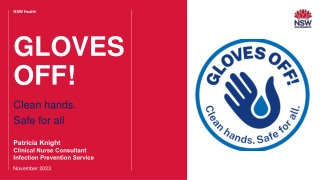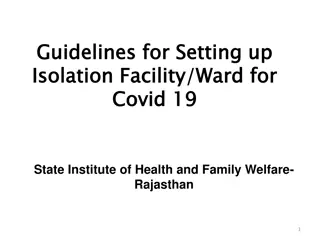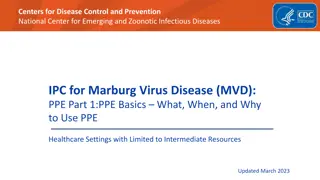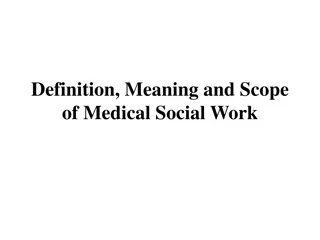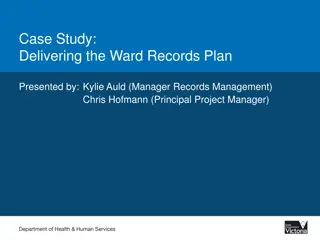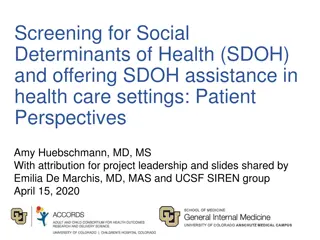Understanding Ward Management in Healthcare Settings
Ward management involves optimizing resources in a ward to provide maximum care and comfort to patients. It includes functions like accommodation, treatment, recovery support, training opportunities, and research possibilities. Different types of wards exist, such as general wards and specific wards tailored to different patient needs. General wards serve non-specific ailments, while specific wards cater to patients requiring specialized care like in ICU or postoperative units.
Download Presentation

Please find below an Image/Link to download the presentation.
The content on the website is provided AS IS for your information and personal use only. It may not be sold, licensed, or shared on other websites without obtaining consent from the author. Download presentation by click this link. If you encounter any issues during the download, it is possible that the publisher has removed the file from their server.
E N D
Presentation Transcript
DEFINITION OF WARD Ward management can be defined as the optimal utilization of the ward resources to produce maximum output, namely, care and comfort of patients. A ward can be conceptualized as a system whose internal environment has ample interaction with the external environment. The internal environment of the ward comprises its physical facilities, e.g., beds, medical equipment, drugs and side laboratories for common investigations and the human resources-the doctors, nurses, ward boys and other paramedical personnel.
FUNCTIONS OF A WARD The prime function of the in-patient area is to provide accommodation for the patient, when their dependence on the others is of a high order. The functions broadly are: Maintenance of normal body activities for which the ward functions as substitute for home and provides comfort to the patient. Examination, diagnosis, investigation and treatment of a patient and depending on his clinical diagnosis, managing his drug treatment, as well as making provision for all other stores, e.g., linen, food etc., required for the patient care.
Helping patients to recover from the illness, physically, emotionally and mentally as well as socially and help them to adjust to their rehabilitation. Provide opportunity for training to medical, nursing and paramedical staff. Provide opportunities for medical research. The indoor facilities provided should be appropriate and with optimum utilization of the available resources.
TYPES OF WARDS 1. GENERAL WARDS 2. SPECIFIC WARDS a) Emergency Ward b) Intensive Care Unit c) Intensive Coronary Care Unit d) Nursery e) Special Septic Nursery f) Burns Ward g) Postoperative Ward h) Postnatal Ward 3. UNITS WITH SPECIALIST NURSING, TREATMENT AND EQUIPMENT.
GENERAL WARD PICTURE
GENERAL WARD PICTURE
GENERAL WARDS In these wards, patients with non-specific ailments, requiring no life saving care are admitted. These are big wards with patient nurse ratio of 5:1, and cater to patient s routine investigative, treatment and care needs, till the patient is discharged. Theses wards have all the basic facilities and the nursing staff spends on an average 30 minutes to 60 minutes per for nursing care.
SPECIFIC WARDS These wards have patients admitted for specific care, due to illness or social reasons; examples are Intensive Care Units(ICU), Intensive Cardiac Care Unit (ICCU), Postoperative Critical Surgical Care Ward, Orthopaedic Wards, maternity Ward, nursery, neonatal intensive care unit, and pediatric intensive care unit, tetanus ward, tuberculosis ward, psychiatric ward, isolation ward, emergency wards, burns ward etc. The type of service provided by a ward is denoted by its name. These services are provided with certain planning considerations:
Related to community Related to service Related to resources Essential features of some of the specific wards are discussed below:
EMERGENCY WARD PICTURE
EMERGENCY WARD Services with trained manpower, equipment and supplies are available round the clock to provide immediate medical, surgical or psychiatric care to acutely ill, severely injured, intoxicated and poisoned patients. Round the-clock availability of specialists concerned with small OT, side lab and X-rays, cardiac monitor and resuscitation kit is ensured. In such wards, there is an average of 8 hours of nursing per patient per day. A patient-nurse ratio of 1:1 is maintained.
INTENSIVE CARE UNIT PICTURE
INTENSIVE CARE UNIT Well-equipped life-saving services with necessary trained staff are provided round the clock for the acutely sick cases. Availability of resuscitation kit, respirator, side lab, X-rays and cardiac monitor, etc., is ensured. All specialists are available round the clock. In such wards, there is an average of 6-8 hours of nursing per patient per day. A patient-nurse ratio of 1:1 is maintained.
INTENSIVE CORONARY CARE UNIT PICTURE
INTENSIVE CORONARY CARE UNIT This ward takes round the clock care of cardiac patients who are acutely ill with the help of trained cardiologist and staff with all cardic equipment and equipment for investigation. In such wards, there is an average of 8-10 hours of nursing per patient per day. A patient-nurse ratio 1:1 is maintained. The moment a patient is out of a danger, he/she is shifted to a general ward.
NURSERY WARD PICTURE
NURSERY This ward is meant for newborn children and is usually near to the obstetrics ward. Efficient care is provided to newborns by trained neonatologists/pediatricians, trained staff. It is a completely aseptic place with aseptic working conditions as in an operating theatre.
SPECIAL SEPTIC NURSERY This is maintained for infection newborns and children born outside the hospital. Room temperature and humidity of the ward are maintained at 24C and 78%respectively. A nurse-child ratio of 1:3 is maintained and the time spent per child per day is about 5 hours.
BURNS WARD PICTURE
BURNS WARD This type of ward is a specialized ward for all cases of burns, providing services through specially trained doctors and staff with complete aseptic conditions and latest equipments for resuscitation, medication and surgery. This ward is kept away from infectious wards.
POSTOPERATIVE WARD This is a special ward to keep all case after surgery till they are fit to move about and stitches are removed. No infected cases are kept around them so that postoperative infections do not develop.
POSTNATAL WARD This is a special ward to keep all cases after delivery to prevent infection to the mother from other general patients.
UNITS WITH SPECIALIST NURSING, TREATMENT AND EQUIPMENT Wards like burns ward, transplant ward are functioning usually at national or regional centers where particular services skills are concentrated.


